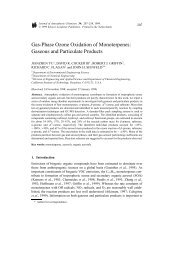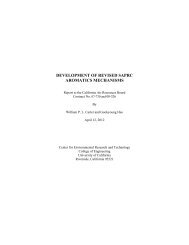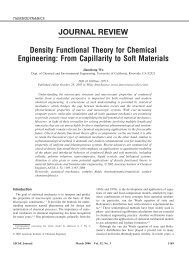Asphaltene precipitation in crude oils: Theory and experiments
Asphaltene precipitation in crude oils: Theory and experiments
Asphaltene precipitation in crude oils: Theory and experiments
You also want an ePaper? Increase the reach of your titles
YUMPU automatically turns print PDFs into web optimized ePapers that Google loves.
large extent, their solubility <strong>in</strong> <strong>crude</strong> oil (Koots <strong>and</strong> Speight,<br />
1975).<br />
Accord<strong>in</strong>g to the field experience (De Boer et al., 1995;<br />
Kokal <strong>and</strong> Sayegh, 1995) <strong>and</strong> experimental observations<br />
(Andersen, 1994; Fotl<strong>and</strong> et al., 1997; Hammami et al., 2000;<br />
Thomas et al., 1992) asphaltene stability depends on a number<br />
of factors, <strong>in</strong>clud<strong>in</strong>g the composition of the surround<strong>in</strong>g fluid,<br />
pressure, <strong>and</strong> temperature. The effect of composition <strong>and</strong> pressure<br />
on asphaltene <strong>precipitation</strong> is generally believed to be<br />
stronger than the effect of temperature. Addition of paraff<strong>in</strong>ic<br />
compounds shifts the solubility of asphaltenes <strong>in</strong> the bulk oil<br />
because its solvent power affects <strong>in</strong>teractions among asphaltenes<br />
<strong>and</strong> res<strong>in</strong>s. If the paraff<strong>in</strong>ic compounds are good solvents<br />
for res<strong>in</strong>s but not for asphaltenes, as the volume of diluent<br />
<strong>in</strong>creases both the <strong>in</strong>teraction between res<strong>in</strong>s <strong>and</strong> asphaltenes<br />
<strong>and</strong> the capacity of the former to stabilize the asphaltene<br />
molecules as small aggregates becomes weak, caus<strong>in</strong>g asphaltenes<br />
to precipitate. Pressure depletion alone can destabilize<br />
asphaltenes <strong>and</strong> is likely the major reason for asphaltene deposition<br />
<strong>in</strong> well-bore pipes. As the density of the <strong>crude</strong> oil<br />
decreases (because of depressurization), the screen<strong>in</strong>g effect on<br />
asphaltene <strong>in</strong>teractions aris<strong>in</strong>g from the presence of oil components<br />
decreases, caus<strong>in</strong>g the <strong>in</strong>teractions between asphaltenes<br />
to become stronger, which <strong>in</strong> turn <strong>in</strong>duces the <strong>precipitation</strong>.<br />
The formation of an asphaltene phase dur<strong>in</strong>g natural production<br />
process depends on pressure <strong>and</strong> temperature. This behavior<br />
can be represented <strong>in</strong> a P–T diagram, where the onset po<strong>in</strong>ts<br />
of asphaltene <strong>precipitation</strong> are localized, draw<strong>in</strong>g asphaltene<br />
stability boundaries, similarly to the conventional hydrocarbon<br />
P–T phase diagram (Leontaritis, 1996). This P–T diagram of<br />
asphaltenic fluids has been called the asphaltene <strong>precipitation</strong><br />
envelope (APE). Published APEs are very scarce. To our<br />
knowledge, the earliest experimental study on the effect of<br />
pressure <strong>in</strong> asphaltene <strong>precipitation</strong> was made by Bilheimer et<br />
al. (1949), <strong>in</strong> mixtures of bitumen with tetral<strong>in</strong> <strong>and</strong> n-pentane<br />
as precipitant. They noted a consistent decrease <strong>in</strong> asphaltene<br />
<strong>precipitation</strong> as pressure <strong>in</strong>creased. This observation was further<br />
validated by Lhioreau et al. (1967) <strong>in</strong> mixtures of <strong>crude</strong> oil<br />
<strong>and</strong> hydrocarbons from methane to n-heptane. Later APEs<br />
were published by Leontaritis <strong>and</strong> Mansoori (1988) for the<br />
Pr<strong>in</strong>os oil, <strong>and</strong> by Leontaritis (1996) for South American <strong>and</strong><br />
North American live <strong>oils</strong>. For these <strong>oils</strong>, it was observed that,<br />
as the temperature <strong>in</strong>creases, the onset pressure decreases,<br />
requir<strong>in</strong>g a bigger pressure change from the orig<strong>in</strong>al reservoir<br />
P–T condition to <strong>in</strong>itiate asphaltene <strong>precipitation</strong>. This is <strong>in</strong><br />
agreement with other observations (Andersen, 1994; Hirschberg<br />
et al., 1984), where asphaltene solubility <strong>in</strong>creased with<br />
temperature. Hirschberg et al. (1984) presented an experimental<br />
study on temperature <strong>and</strong> pressure effects on the amount <strong>and</strong><br />
nature of asphaltenic material precipitated. Accord<strong>in</strong>g to their<br />
results, high temperatures <strong>and</strong> pressures favored asphaltene<br />
solubility <strong>and</strong> further supported evidence on the reversibility of<br />
asphaltene <strong>precipitation</strong>. Hammami et al. (2000) measured the<br />
APE for various Gulf of Mexico live <strong>oils</strong> through a series of<br />
isothermal pressure depletion <strong>experiments</strong>, obta<strong>in</strong><strong>in</strong>g evidence<br />
of asphaltene <strong>precipitation</strong> above the saturation pressure <strong>and</strong><br />
asphaltene redissolution below this pressure, <strong>and</strong> show<strong>in</strong>g that<br />
the pressure-depletion–<strong>in</strong>duced asphaltene <strong>precipitation</strong> is a<br />
reversible process. The reversibility of asphaltene <strong>precipitation</strong><br />
has been subject to question by some authors; slow k<strong>in</strong>etics of<br />
dispersion or flocculation makes it difficult to determ<strong>in</strong>e<br />
whether such a process is reversible (Buckley, 1999). For<br />
<strong>in</strong>stance, Fotl<strong>and</strong> (1997) suggested that asphaltene <strong>precipitation</strong><br />
is an irreversible process, especially when the <strong>crude</strong> oil is<br />
under conditions far from <strong>precipitation</strong> onset. On the other<br />
h<strong>and</strong>, Joshi et al. (2001) found that asphaltene <strong>precipitation</strong> <strong>in</strong><br />
live <strong>oils</strong> is clearly reversible with pressure, although a subtle<br />
irreversibility may occur.<br />
Shields (2000) reported an APE measured for a Mexican<br />
<strong>crude</strong> oil. The effect of asphaltene <strong>precipitation</strong> <strong>in</strong>hibitors on<br />
the onset pressure as a function of temperature was studied by<br />
Aqu<strong>in</strong>o-Olivos et al. (2001) by compar<strong>in</strong>g the APEs measured<br />
from live-oil fluids with different concentrations of <strong>in</strong>hibitor.<br />
Later, Aqu<strong>in</strong>o-Olivos et al. (2003) separated asphaltenic material<br />
from pressure-preserved bottom-hole oil samples at conditions<br />
between the onset <strong>and</strong> bubble po<strong>in</strong>t pressures us<strong>in</strong>g a bulk<br />
high-pressure filtration technique. After characteriz<strong>in</strong>g the separated<br />
material, important chemical <strong>and</strong> structural differences<br />
were found between this type of asphaltene <strong>and</strong> the conventional<br />
n-heptane asphaltenes separated by the st<strong>and</strong>ard procedure<br />
from exp<strong>and</strong>ed samples of the same <strong>oils</strong>.<br />
The study of asphaltene <strong>precipitation</strong> upon addition of n-<br />
alkane solvents to stock-tank <strong>oils</strong> has often been used <strong>in</strong> the<br />
underst<strong>and</strong><strong>in</strong>g of the <strong>precipitation</strong> phenomena. Hirschberg et<br />
al. (1984) <strong>and</strong> Chung et al. (1991) reported a series of titration<br />
<strong>experiments</strong> <strong>in</strong> tank-oil samples with liquid alkanes from n-<br />
pentane to n-hexadecane as diluents, to determ<strong>in</strong>e the <strong>precipitation</strong><br />
onset composition, the amount of material precipitated,<br />
<strong>and</strong> the solubility properties of asphaltenes. Kokal et al. (1992)<br />
reported the amount of asphaltenes precipitated when two<br />
Canadian heavy <strong>oils</strong> with a high content of asphaltenes (13 <strong>and</strong><br />
21 wt %) were titrated with various n-alkanes (n-pentane to<br />
n-decane) at different dilution ratios. They observed that above<br />
a ratio of 10 mL solvent/g oil, the <strong>precipitation</strong> is completed<br />
<strong>and</strong> also a decrease <strong>in</strong> the amount precipitated at very high<br />
dilution ratios was observed, which can be attributed, <strong>in</strong> part, to<br />
a partial redissolution of asphaltenes <strong>in</strong> the solvent. Rassamdana<br />
<strong>and</strong> Sahimi (1996) measured the amount of precipitated<br />
asphaltene from an Iranian <strong>crude</strong> oil us<strong>in</strong>g normal alkanes with<br />
carbon number rang<strong>in</strong>g from 5 to 10 at 25°C <strong>and</strong> atmospheric<br />
pressure. These authors also studied the effect of pressure <strong>and</strong><br />
temperature on <strong>precipitation</strong>. Their results are consistent with<br />
previous observations (Hirschberg et al., 1984). A common<br />
feature <strong>in</strong> all these <strong>in</strong>vestigations is that the amount of precipitated<br />
material decreases as the n-alkane carbon number of the<br />
solvent <strong>in</strong>creases, <strong>and</strong> that complete <strong>precipitation</strong> is obta<strong>in</strong>ed<br />
above a certa<strong>in</strong> solvent/oil ratio (typically between 10 <strong>and</strong> 30<br />
cm 3 /g).<br />
The experimental study of the effects of pressure, temperature,<br />
<strong>and</strong> composition on asphaltene <strong>precipitation</strong> has been<br />
important to underst<strong>and</strong> the basic mechanisms of asphaltene<br />
phase formation, <strong>and</strong> provides the necessary <strong>in</strong>put for development<br />
<strong>and</strong> validation of thermodynamic models of asphaltene<br />
<strong>precipitation</strong>, as it will be discussed next.<br />
Model<strong>in</strong>g asphaltene <strong>precipitation</strong><br />
The development of asphaltene <strong>precipitation</strong> models has<br />
been based ma<strong>in</strong>ly on two different conceptual descriptions of<br />
asphaltene solutions: (1) asphaltenes <strong>and</strong> res<strong>in</strong>s are considered<br />
as molecular entities dissolved <strong>in</strong> <strong>crude</strong> oil; <strong>and</strong> (2) asphaltene<br />
AIChE Journal October 2004 Vol. 50, No. 10<br />
2553
















